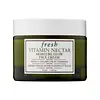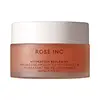What's inside
What's inside
 Key Ingredients
Key Ingredients

 Benefits
Benefits

 Concerns
Concerns

 Ingredients Side-by-side
Ingredients Side-by-side

Water
Skin ConditioningGlycerin
HumectantPentylene Glycol
Skin ConditioningEthylhexyl Isononanoate
EmollientPolyglyceryl-6 Stearate
EmollientPolyglycerin-3
HumectantCaprylic/Capric Triglyceride
MaskingJojoba Esters
EmollientPropanediol
SolventSodium Polyacrylate
AbsorbentEthylhexyl Palmitate
EmollientStearic Acid
CleansingCaprylyl Glycol
EmollientChlorphenesin
AntimicrobialPolyglyceryl-6 Behenate
Emulsion StabilisingAcrylates/C10-30 Alkyl Acrylate Crosspolymer
Emulsion StabilisingParfum
MaskingSodium Stearoyl Glutamate
CleansingTocopheryl Acetate
AntioxidantXanthan Gum
EmulsifyingTrisodium Ethylenediamine Disuccinate
Glucosyl Hesperidin
HumectantLimonene
PerfumingSodium Hydroxide
BufferingAscorbyl Tetraisopalmitate
AntioxidantPanthenol
Skin ConditioningSodium Hyaluronate
HumectantMagnesium Aspartate
Skin ConditioningZinc Gluconate
Skin ConditioningVaccinium Myrtillus Fruit Extract
Skin ConditioningLinalool
PerfumingCaramel
Cosmetic ColorantSaccharum Officinarum Extract
MoisturisingCopper Gluconate
Skin ConditioningCitral
PerfumingCitrus Aurantium Dulcis Fruit Extract
MaskingCitrus Limon Fruit Extract
MaskingTocopherol
AntioxidantAcer Saccharum Extract
Skin ConditioningWater, Glycerin, Pentylene Glycol, Ethylhexyl Isononanoate, Polyglyceryl-6 Stearate, Polyglycerin-3, Caprylic/Capric Triglyceride, Jojoba Esters, Propanediol, Sodium Polyacrylate, Ethylhexyl Palmitate, Stearic Acid, Caprylyl Glycol, Chlorphenesin, Polyglyceryl-6 Behenate, Acrylates/C10-30 Alkyl Acrylate Crosspolymer, Parfum, Sodium Stearoyl Glutamate, Tocopheryl Acetate, Xanthan Gum, Trisodium Ethylenediamine Disuccinate, Glucosyl Hesperidin, Limonene, Sodium Hydroxide, Ascorbyl Tetraisopalmitate, Panthenol, Sodium Hyaluronate, Magnesium Aspartate, Zinc Gluconate, Vaccinium Myrtillus Fruit Extract, Linalool, Caramel, Saccharum Officinarum Extract, Copper Gluconate, Citral, Citrus Aurantium Dulcis Fruit Extract, Citrus Limon Fruit Extract, Tocopherol, Acer Saccharum Extract
Water
Skin ConditioningPropanediol
SolventCaprylic/Capric Triglyceride
MaskingGlycerin
HumectantBetaine
HumectantPentylene Glycol
Skin ConditioningSqualane
EmollientNiacinamide
SmoothingLimnanthes Alba Seed Oil
Skin ConditioningCoco-Caprylate/Caprate
EmollientCentella Asiatica Leaf Cell Extract
AntioxidantPalmitoyl Tetrapeptide-7
Skin ConditioningAscorbyl Tetraisopalmitate
AntioxidantTocopherol
AntioxidantLactic Acid
BufferingChrysin
Skin ConditioningCastor Oil/Ipdi Copolymer
Helianthus Annuus Seed Oil
EmollientRosmarinus Officinalis Leaf Extract
AntimicrobialSynthetic Fluorphlogopite
Acrylates/C10-30 Alkyl Acrylate Crosspolymer
Emulsion StabilisingTrisodium Ethylenediamine Disuccinate
CI 77491
Cosmetic ColorantBenzyl Alcohol
PerfumingCitric Acid
BufferingSodium Hydroxide
BufferingPelargonium Graveolens Stem Leaf Oil
PerfumingCitrus Aurantium Bergamia Fruit Oil
MaskingCitral
PerfumingCitronellol
PerfumingGeraniol
PerfumingLimonene
PerfumingLinalool
PerfumingWater, Propanediol, Caprylic/Capric Triglyceride, Glycerin, Betaine, Pentylene Glycol, Squalane, Niacinamide, Limnanthes Alba Seed Oil, Coco-Caprylate/Caprate, Centella Asiatica Leaf Cell Extract, Palmitoyl Tetrapeptide-7, Ascorbyl Tetraisopalmitate, Tocopherol, Lactic Acid, Chrysin, Castor Oil/Ipdi Copolymer, Helianthus Annuus Seed Oil, Rosmarinus Officinalis Leaf Extract, Synthetic Fluorphlogopite, Acrylates/C10-30 Alkyl Acrylate Crosspolymer, Trisodium Ethylenediamine Disuccinate, CI 77491, Benzyl Alcohol, Citric Acid, Sodium Hydroxide, Pelargonium Graveolens Stem Leaf Oil, Citrus Aurantium Bergamia Fruit Oil, Citral, Citronellol, Geraniol, Limonene, Linalool
Ingredients Explained
These ingredients are found in both products.
Ingredients higher up in an ingredient list are typically present in a larger amount.
Acrylates/C10-30 Alkyl Acrylate Crosspolymer is a synthetic polymer. It is used to thicken and improve the texture of products. Due to its properties, it can prevent water and oil ingredients from separating.
Ascorbyl Tetraisopalmitate is a version of ascorbic acid, or Vitamin C.
This ingredient has many benefits including reducing wrinkles, skin soothing, dark spot fading, and fighting against free radicals.
It helps with dark spot fading by interfering with the process of skin darkening, helping to reduce hyperpigmentation. Like other forms of vitamin C, this ingredient encourages the skin to create more collagen.
As an antioxidant, it helps fight free-radicals. Free-radicals are molecules that may damage your skin cells.
One study found Ascorbyl Tetraisopalmitate to degrade in sunlight, but is stabilized when combined with acetyl zingerone.
Learn more about Ascorbyl TetraisopalmitateThis ingredient is an emollient, solvent, and texture enhancer. It is considered a skin-softener by helping the skin prevent moisture loss.
It helps thicken a product's formula and makes it easier to spread by dissolving clumping compounds.
Caprylic Triglyceride is made by combining glycerin with coconut oil, forming a clear liquid.
While there is an assumption Caprylic Triglyceride can clog pores due to it being derived from coconut oil, there is no research supporting this.
Learn more about Caprylic/Capric TriglycerideCitral is a fragrance and used to add a lemon-like scent to products. It is both naturally found in plants and created synthetically. In plants, it is commonly occurring in lemon myrtle, lemongrass, lemon tea-tree, lemon verbena, and other citruses.
The EU mandates Citral be listed separately as a fragrance. It is a known allergen and may cause contact dermatitis. Citral can also used as a masking ingredient.
The term 'fragrance' is not regulated in many countries. In many cases, it is up to the brand to define this term. For instance, many brands choose to label themselves as "fragrance-free" because they are not using synthetic fragrances. However, their products may still contain ingredients such as essential oils that are considered a fragrance.
The term 'citral' is a collective term for two geometric isomers: geranial/Citral A and neral/Citral B.
Learn more about CitralGlycerin is already naturally found in your skin. It helps moisturize and protect your skin.
A study from 2016 found glycerin to be more effective as a humectant than AHAs and hyaluronic acid.
As a humectant, it helps the skin stay hydrated by pulling moisture to your skin. The low molecular weight of glycerin allows it to pull moisture into the deeper layers of your skin.
Hydrated skin improves your skin barrier; Your skin barrier helps protect against irritants and bacteria.
Glycerin has also been found to have antimicrobial and antiviral properties. Due to these properties, glycerin is often used in wound and burn treatments.
In cosmetics, glycerin is usually derived from plants such as soybean or palm. However, it can also be sourced from animals, such as tallow or animal fat.
This ingredient is organic, colorless, odorless, and non-toxic.
Glycerin is the name for this ingredient in American English. British English uses Glycerol/Glycerine.
Learn more about GlycerinLimonene is a fragrance that adds scent and taste to a formulation.
It's found in the peel oil of citrus fruits and other plants such as lavender and eucalyptus. The scent of limonene is generally described as "sweet citrus".
Limonene acts as an antioxidant, meaning it helps neutralize free radicals.
When exposed to air, oxidized limonene may sensitize the skin. Because of this, limonene is often avoided by people with sensitive skin.
The term 'fragrance' is not regulated in many countries. In many cases, it is up to the brand to define this term. For instance, many brands choose to label themselves as "fragrance-free" because they are not using synthetic fragrances. However, their products may still contain ingredients such as essential oils that are considered a fragrance.
Learn more about LimoneneLinalool is a fragrance and helps add scent to products. It's derived from common plants such as cinnamon, mint, citrus, and lavender.
Like Limonene, this ingredient oxidizes when exposed to air. Oxidized linalool can cause allergies and skin sensitivity.
This ingredient has a scent that is floral, spicy tropical, and citrus-like.
Learn more about LinaloolPentylene glycol is typically used within a product to thicken it. It also adds a smooth, soft, and moisturizing feel to the product. It is naturally found in plants such as sugar beets.
The hydrophilic trait of Pentylene Glycol makes it a humectant. As a humectant, Pentylene Glycol helps draw moisture from the air to your skin. This can help keep your skin hydrated.
This property also makes Pentylene Glycol a great texture enhancer. It can also help thicken or stabilize a product.
Pentylene Glycol also acts as a mild preservative and helps to keep a product microbe-free.
Some people may experience mild eye and skin irritation from Pentylene Glycol. We always recommend speaking with a professional about using this ingredient in your routine.
Pentylene Glycol has a low molecular weight and is part of the 1,2-glycol family.
Learn more about Pentylene GlycolPropanediol is an all-star ingredient. It softens, hydrates, and smooths the skin.
It’s often used to:
Propanediol is not likely to cause sensitivity and considered safe to use. It is derived from corn or petroleum with a clear color and no scent.
Learn more about PropanediolSodium Hydroxide is also known as lye or caustic soda. It is used to adjust the pH of products; many ingredients require a specific pH to be effective.
In small amounts, sodium hydroxide is considered safe to use. However, large amounts may cause chemical burns due to its high alkaline.
Your skin has a natural pH and acid mantle. This acid mantle helps prevent harmful bacteria from breaking through. The acid mantle also helps keep your skin hydrated.
"Alkaline" refers to a high pH level. A low pH level would be considered acidic.
Learn more about Sodium HydroxideTocopherol (also known as Vitamin E) is a common antioxidant used to help protect the skin from free-radicals and strengthen the skin barrier. It's also fat soluble - this means our skin is great at absorbing it.
Vitamin E also helps keep your natural skin lipids healthy. Your lipid skin barrier naturally consists of lipids, ceramides, and fatty acids. Vitamin E offers extra protection for your skin’s lipid barrier, keeping your skin healthy and nourished.
Another benefit is a bit of UV protection. Vitamin E helps reduce the damage caused by UVB rays. (It should not replace your sunscreen). Combining it with Vitamin C can decrease sunburned cells and hyperpigmentation after UV exposure.
You might have noticed Vitamin E + C often paired together. This is because it is great at stabilizing Vitamin C. Using the two together helps increase the effectiveness of both ingredients.
There are often claims that Vitamin E can reduce/prevent scarring, but these claims haven't been confirmed by scientific research.
Learn more about TocopherolTrisodium Ethylenediamine Disuccinate is used to help stabilize a product.
It is a chelating agent, meaning it helps prevent metal ions from binding to other ingredients. This prevents unwanted reactions in products. Metal ions can come into a product via the water ingredient. They are found in trace amounts and are not known to be harmful.
Water. It's the most common cosmetic ingredient of all. You'll usually see it at the top of ingredient lists, meaning that it makes up the largest part of the product.
So why is it so popular? Water most often acts as a solvent - this means that it helps dissolve other ingredients into the formulation.
You'll also recognize water as that liquid we all need to stay alive. If you see this, drink a glass of water. Stay hydrated!
Learn more about Water